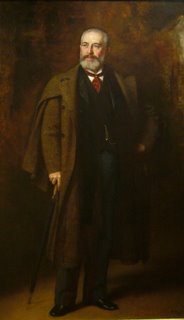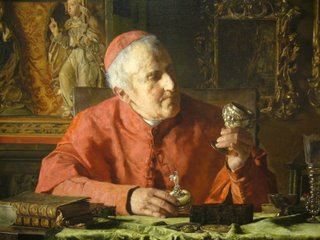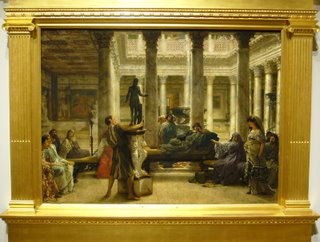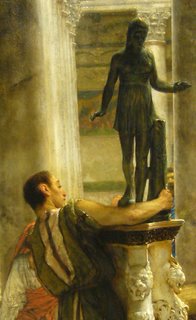Frederick Layton

Frederick Layton, depicted above by Eastman Johnson in 1893, was a Milwaukee meatpacker who used his fortune to start an art museum based on his own taste - which for his time, was mainstream European: he liked the skillful depiction of engaging narrative -- and he had no use for the avant-garde of his day -- the Impressionists and the Post-Impressionists whose work fills every other American museum today.

Here's a good example of what he liked -- by one August Johann Holmberg (1851-1921),a name that no one but the specialist will recognize today.

But, still, I think he was quite a painter -- undertaking that most perverse of 19th Century themes: the pampered lives of fussy old clergy -- and delivering a sensual feast of aging flesh and exquisite art objects

And he collected that epitome of Second-Empire decadance -- that dreaded anti-hero of the stuffy old academy: William Bouguereau -- with this classic depiction of the Blind Homer.
Everyone who has ever taken an art history class in the past 80 years knows how really, really bad this artist is -- but he's so bad -- that it's nearly impossible to see any of his major work in museums.
Well, this one probably qualifies as a major work -- but I have to admit -- I'm siding with the majority here -- for me, it's visuality is joyless -- and it's narrative trivializes the subject by making a barking dog the center of attention. Don't dogs bark at every stranger ? It's as banal and dumb as Sunday-school illustrations -- and the only good thing that could be said for it is -- it's a very good painting of somebody's dog.
There was also a dreamy female by Lord Leighton -- but being covered with glass -- it could not be photographed through the reflections.

This Alma-Tadema Roman fantasy was more enjoyable however -- especially for anyone who's had to conjugate Latin verbs -- and spent hours in dusty classrooms dreaming about life in the age of Caesar.
It's not great -- it makes me wish that Tintoretto had painted it instead

-- but I'm so hungry for visions of ancient Rome -- this one will suffice

-- and how can I not like the subject matter: a collector showing his friends the statue he just bought.

But the piece-de-resistance of the Layton collection -- at least for me -- was "The Old Stagecoach" of 1871 by Eastman Johnson.
There appear to be copies of this painting in other museums --- so I'm guessing that it was a big hit in its time -- and it certainly is a hit with me -- with that ecstatic light-heartedness of an American boyhood (was this lifted from Bingham's "Jolly Flatboatmen" of 1846 ?)
I like the goofy kids playing horses -- I like the girl carrying a basket of treats -- I like the smaller girl trying to get her to slow down -- I like the warm,harvesty colors

It's triumphant -- the triumph of youth -- and even as it ages, fades, and eventually dies -- its goofy, manic, artless, inarticulate energy -- is always triumphant -- while the coach and its riders are going nowhere -- just round and round in the great cycle of birth and death.
Hurrah to Eastman Johnson -- and hurrah to the meatpacker from Milwaukee who loved paintings.


1 Comments:
I love the Holmberg, and will try to memorize the name. It's quite a little Holbein, isn't it?
As for Bourgereau: he said that all he wanted to do in life is paint naked chicks with good skin -- and he did that rather well: people with love for naked chicks with good skin, like myself, and tired of meaning in art, are capabale of enjoying those productions of his; and i am; but, like you, I don't care for the Homer (too much meaning? not enough skin?)
what a joy to come back to your blog after a month and to see all these wonderful posts -- and photos!
Post a Comment
<< Home